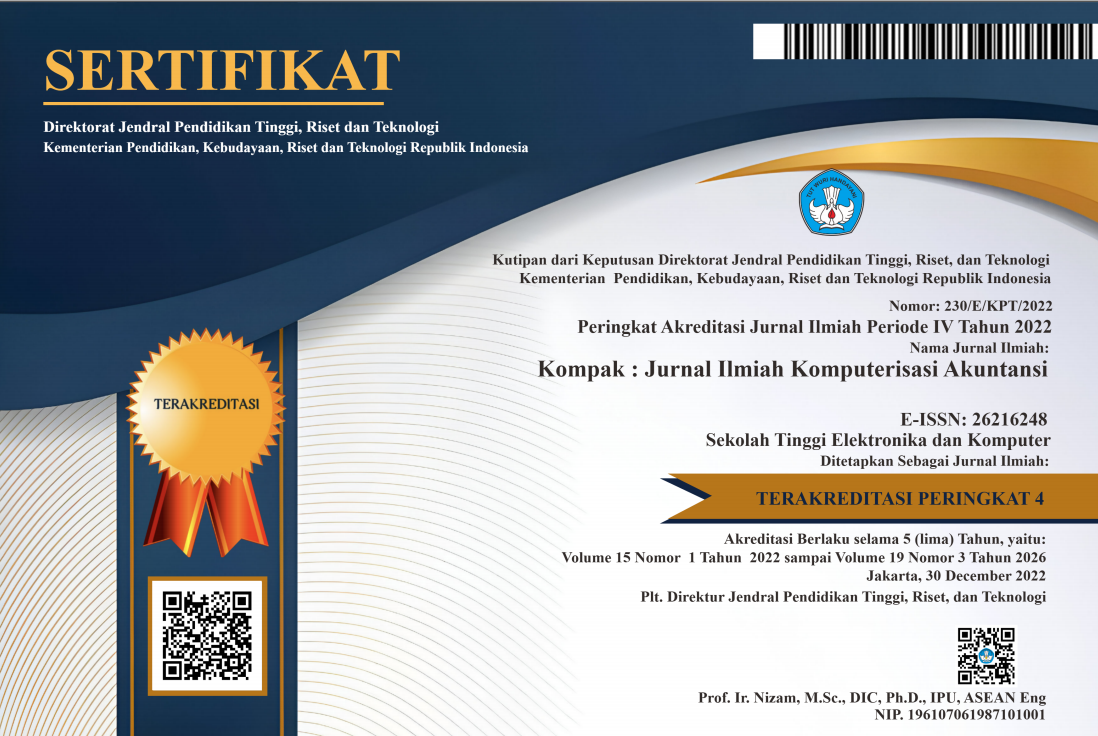Pengaruh Sistem Informasi Akuntansi, E - Commerce, dan Media Sosial terhadap Keputusan untuk Berwirausaha
DOI:
https://doi.org/10.51903/kompak.v17i1.1697Kata Kunci:
Accounting Information Systems, E-Commerce, Social Media, EntrepreneurshipAbstrak
Information technology is very important for business, including accounting information systems. One way businesses use information technology to increase their competitiveness is e-commerce. Additionally, social media helps in implementing online marketing strategies. The aim of this research is to evaluate and analyze the impact of accounting information systems, e-commerce and social media on decisions made by entrepreneurs. This type of research is quantitative and uses an accidental sampling method to produce 230 respondents. This research collects data by distributing questionnaires on the network using Google Form, and data analysis is carried out using the SmartPLS SEM application for quantitative analysis. The conclusion of the t test shows that accounting information systems, e-commerce, and social media have a positive and significant impact on decisions made by entrepreneurs.
Referensi
[2] A. . L. S. S. Rai and R. B. Welker, “Assessing the Validity of IS Success Models: An Empirical Test and Theoretical Analysis.,” J. Inf. Syst. Res., vol. 13, no. http://dx.doi.org/10.1287/isre.13.1.50.96, pp. 50–69, 2002.
[3] D. Yadewani1 and R. Wijaya2, “JURNAL RESTI (Rekayasa Sistem dan Teknologi I nformasi) Pengaruh E-Commerce Terhadap Minat Berwirausaha (Studi Kasus : AMIK Jayanusa Padang),” 2017, [Online]. Available: http://jurnal.iaii.or.id
[4] F. N. Hakim and A. Syahfrudin Z, “Analisis Pengaruh E-Commerce dan Sistem Informasi Akuntansi Dalam Pengambilan Keputusan Untuk Berwirausaha (Studi Empiris Pada Mahasiswa Program Studi Akuntansi Fakultas Ekonomi Universitas Muhammadiyah Jember Angkatan 2016),” 2020.
[5] P. Ganotakis and V. Lindsay, “E-commerce adoption within an entrepreneurial context,” Acad. Manag. J., no. 1, pp. 1–39, 2016.
[6] R. H. Walker and Lester W. Johnson, “ Why Consumer Use and Do Not Use Technology-Enabled. Journal of Service Marketing,” J. Serv. Mark., vol. 20, 2006.
[7] W. Y. Agustina, H. Widianti, and A. Yasmin, “Pengaruh Pemanfaatan E-Commerce dan Media Sosial Terhadap Minat Berwirausaha Pelajar Di Kota Tegal,” Angew. Chemie Int. Ed. 6(11), 951–952., pp. 2013–2015, 2021.
[8] F. D. Davis, . Perceived usefulness, perceived ease of use, and user acceptance of information technology, vol. 13(3), 319. MIS Quarterly, 1989.
[9] I. Ajzen, “The theory of planned behavior,” Organ. Behav. Hum. Decis. Process., vol. 50, no. 2, pp. 179–211, 1991, doi: 10.1016/0749-5978(91)90020-T.
[10] M. Trihudiyatmanto, “Membangun Minat Berwirausaha Mahasiswa Dengan Pengaruh Faktor E-Commerce, Pengetahuan Kewirausahaan dan Gender,” J. Penelit. dan Pengabdi. Kpd. Masy. UNSIQ, vol. 6, no. 2, pp. 93–103, May 2019, doi: 10.32699/ppkm.v6i2.678.
[11] S. Nursito and A. J. S. Nugroho, “1690-4867-1-SM,” 2013.
[12] S. D. Anggadini and L. Puspitawati, “Sistem Informasi Akuntansi,” Graha Ilmu, 2011.
[13] R. Puspitasari, “PENGARUH SISTEM INFORMASI AKUNTANSI DAN PERCEIVED USEFULNESS TERHADAP EFEKTIVITAS SISTEM PENGENDALIAN INTERNAL PENJUALAN (STUDI PADA PT GERONGAN SURAJAYA) Andayani Sekolah Tinggi Ilmu Ekonomi Indonesia (STIESIA) Surabaya.”
[14] L. Thoyibie, “Psikologi Sosial Media,” Artik. Online, 2010.
[15] Ananda Sabil Hussein, “Penelitian bisnis dan manajemen menggunakan partial least squares (PLS) dengan smart PLS 3.0. Modul ajar jurusan manajemen fakultas ekonomi dan bisnis unversitas Brawijaya,” 2015.
[16] Chin. W. W., “The partial least squares approach for structural equation modeling. In G. A. Marcoulides (Ed.), Modern methods for business research,” Lawrence Erlbaum Assoc. Publ., pp. 295–336, 1998.
[17] W. C. B. B. J. B. Joseph F. Hair, “Multivariate Data Analysis,” 2010.
[18] I. Ghozali, “Aplikasi analisis Multivariate dengan Program SPSS,” Badan Penerbit UNDIP, Semarang., 2014.














.png)



